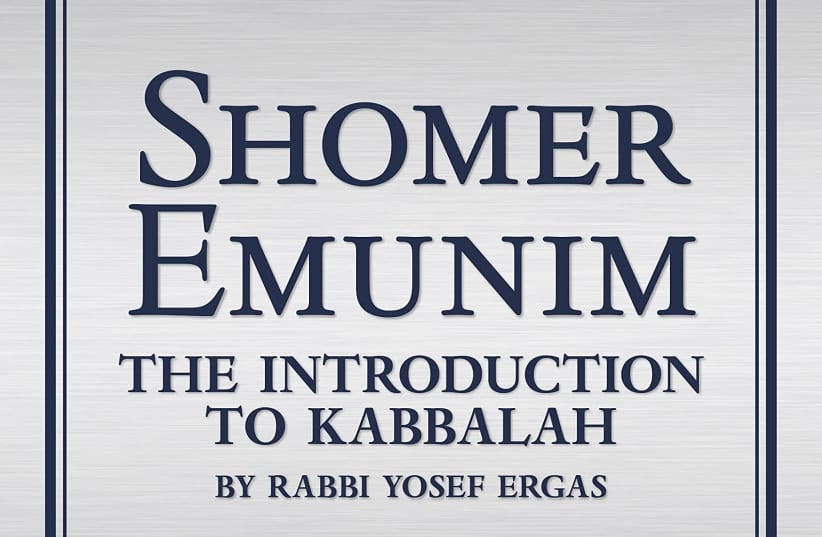The study of Kabbalah, traditionally the purview of Jewish mystics and academic scholars, has become much more popular in recent years. However, in order to properly understand the basics of Kabbalah, an introduction to its world and concepts is needed for every serious student.
One can certainly ask whether that introduction should be given directly to the student by a person immersed in its wisdom, or whether a book sufficient. One of the best-known written introductions to the Kabbalah is that written by Rabbi Yosef Ergas (1685-1730), titled Shomer Emunim, which was recently translated into English by Rabbi Avinoam Fraenkel.
In addition to the translation, which runs for 500 pages, Fraenkel has written his own over-300-page introduction to the basic concepts of Kabbalah.
Shomer Emunim itself is divided into two parts. In the words of the author, “The first debate brings a few proofs about the authenticity of the chain of receipt of hidden Kabbalistic wisdom [through the generations], notwithstanding the perspective of the pashtanim who strongly oppose it, showing them their error and their faulty logic...The second debate explains several fundamentals of the faith.”
And both sections are structured as a debate between two scholars.
Fraenkel, in his introduction, writes:
“A novice in Torah study cannot fruitfully study advanced Kabbalah without first gaining a strong grounding and showing a determined commitment to both the lower levels of Torah study and the performance of the mitzvot.”
He also relates to the question of the correct age for starting to learn Kabbalah, and writes: “The key requirement [as opposed to age] is the attainment of a level of intellectual maturity rather than setting a specific minimum age”
Fraenkel continues, “Kabbalah study is clearly the level of Torah study that everyone is obliged to aspire towards as they grow in their Torah knowledge.”
What’s interesting to me is that in many of the major institutions of Torah study, both in Israel and abroad, the study and mastery of Kabbalah is not emphasized or even aspired to. Do these yeshivot disagree with Fraenkel’s contention that Kabbalah is “the level of Torah study that everyone is obliged to aspire towards,” or is there another reason for the absence of Kabbalah in their curriculums?
In Fraenkel’s own introduction he has a long polemic against those who argue against the authenticity of the Kabbalah and in particular an attack on Rabbi Yihya Qafih (1850-1931) from Yemen, who publicly denounced Kabbalah and claimed it had no authority. This section of the book could have been strengthened by referencing the multitude of academic studies dealing with this question, which could have helped shed light on this important issue in Kabbalah studies.
In addition, what Fraenkel writes, following Rabbi Ergas, that the Rambam did not write about Kabbalah because he was not a recipient of the tradition, is not an intellectually satisfying answer to the current reader.
Regarding the text itself, it is a highly readable translation of this landmark work of Kabbalah and is accompanied by a comprehensive index and extensive footnotes.
Reading as a novice to Kabbalah, I found the first section dealing with the question of the authenticity of Kabbalah more approachable than the second section, which relates to explaining basic principles of Kabbalah.
This perhaps relates to the fact that maybe these sections are better taught with the guidance of a teacher; or, as Fraenkel points out, “no Kabbalistic concept that we may encounter should ever be misinterpreted in any way that legitimizes thinking about our Creator as having any form of multiplicity, limitation or physicality.”
The book itself addresses and explains such fundamental Kabbalistic concepts as “how the belief in God, His descriptions and His Names are understood according to the received traditions of the Kabbalists.”
FRAENKEL MAINTAINS that Kabbalistic principles converge with modern science and technological change.
For example, in the Kabbalah overview section, he summarizes the disagreement between contemporary physicists whether the laws of nature operate according to a reductionist or emergence model. According to the reductionists, all laws of nature follow the rules of the behavior of the smallest subatomic particles, while the emergent model argues that the atomic world and the visible world can operate using different rules.
Fraenkel then argues that this theory of emergence can be used to explain the Kabbalistic notion of different levels of God’s revelation in the world.
In his own words, “It is through cycles of emergence that relative underlying states of separation, uncertainty, shattered tohu [chaos] and reduction are transformed into ever higher partzufim [metaphorical figures of human likeness] of relative states of tighter integration, certainty and tikkun [repair].
And this is where he loses me, as it is difficult for me to see the connection between the spiritual world of Kabbalah and modern physics, but this might be due to me being an unrepentant Maimonidean Jew.
In any event, by translating and elucidating this foundational text, Fraenkel has done a tremendous service to those students interested in obtaining a traditional introduction to the world of Kabbalah.
But be assured it is not easy reading and is certainly not for everyone, but should be studied and savored by those who desire the Kabbalah’s wisdom and spiritual guidance. ■
Shomer Emunim
The Introduction to Kabbalah
By Rabbi Yosef Ergas
Commentary by Avinoam Fraenkel
Urim Publications
1,080 pages; $39.95

